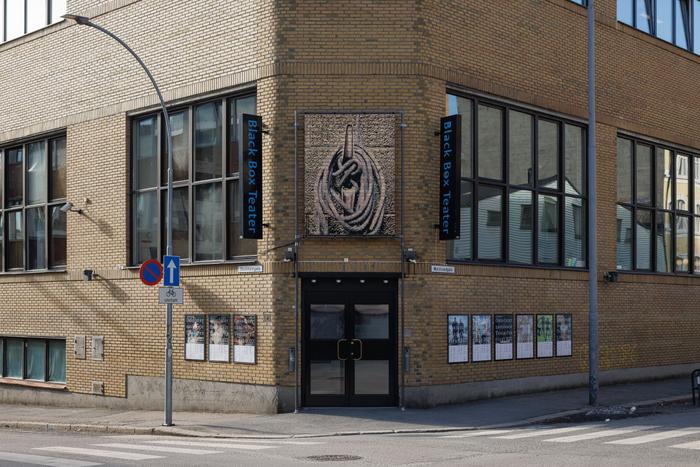As someone who primarily uses the theatre to see a couple of productions per semester, and who doesn’t work within the theatrical arts myself, I find myself standing outside of the theatre one day in March 2022 observing the inside of the theatre through the façade’s LED display. Traces of activity and close-up details of the interior are shown in an unhurried and beautiful stream of images. These are pictures of details that, I assume, will jog the memories of those who are familiar with Black Box Teater’s various rooms, nooks, and crannies. For me, viewing it from the outside, the unfolding display works mostly as a meditative flow. I’m not familiar with the manifold layers of history that are stored in the theatre’s walls, nor do I know what it will actually entail for the art and stagecraft communities that they must relocate from this venue. But the pictures give me the opportunity to catch a few glimpses from the inside – glimpses of material structures that say something about the venue’s identity as a theatre and as a production site. As I stand there looking at the stream of pictures, I gradually gain a sense of the venue and of its atmosphere and logics. With his scenographic work on the theatre’s façade, Jakob Oredsson turns the venue inside out and prompts me to link the small traces he presents to my own associations and memories from Black Box teater. This creates a new experience of, and relation to, the place itself.
The shifting images of surface details fades into and out of focus, alternating between almost merging with the building and standing conspicuously out from it. Functioning as a leitmotif, a picture of the actual brick wall behind the LED display repeatedly turns up between the various images. Both in its scale and its chromatic reproduction, this picture of the brick wall is so verisimilar that for brief moments the illusion is created that the display has disappeared and that we are looking directly at the façade, at the theatre’s surface. The various images come gradually to the fore “through” the wall, becoming clear and in focus until they gradually fade out again. As the physical perquisite for the theatre’s activities, the brick wall becomes the visual cornerstone of Oredsson’s scenographic piece. By putting the picture of the wall on the display, and the display on the wall, Oredsson plays around with the concepts of foreground and background: What do we usually notice, and what escapes our attention?
The details highlight the intimacy of the interiors and the architecture, visual markers that in tandem help create a place. In this piece, they have been separated from the overall context and presented individually. At the same time, one of the entirely fundamental elements of the theatre experience is strikingly absent from the pictures, namely people. The theatre and the field of performance are of course grounded in a social context: without people, there are no encounters, and no theatrical art is created.




